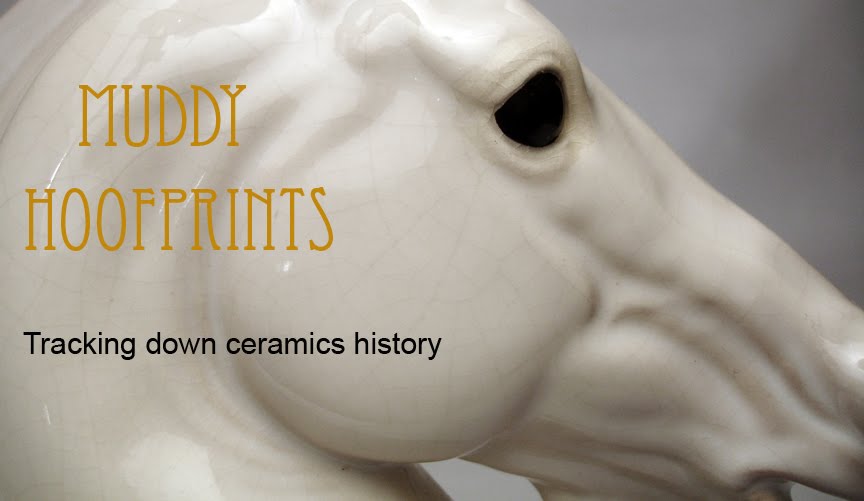Shown at the top of the page, the caption reads:
Standing only 3.8" tall, this Morgan stallion was created from Plasti-Carve, a modelling material. Maureen said she did it a long time ago, just for herself.
Until very recently, I would never have guessed otherwise. It absolutely looks exactly as described above. Plasti-Carve is a porcelain powder-infused wax, for carving and casting. When it is reused over years, it can indeed turn from its creamy white to a dirty, speckled tan.
The only example known, and thought to be an original wax carving, this piece was sold in the Maureen Love estate auction in June 2005. It had sustained damage while in Maureen's collection, and still bore the plumber's epoxy putty she had mended it with. The epoxy is sort of thick and smooshed out between the breaks.
It's not exactly pretty, and could do with an update. This year, I was commissioned to restore it for its current owner. It stands 3.75" tall and has no stallion genitalia at all. When I first held the model, it didn't feel like Plasti-Carve.
I rapped it with a fingernail... and it "tinked" in answer. I turned it over, and found it had been slipcast. The concentric "tree rings" in this broken leg further attest that it is slipcast clay. If a horse is slipcast, it follows that there is a mold of it!
The gray coloration was a dipped art glaze, which had crawled and pin-holed badly. It was, in fact, fired ceramic!
What kind of ceramic clay body did she cast it in? This calls for the water droplet test!
The water droplet took a seat and stuck around for a visit. Since it didn't disappear into the exposed clay surface, that meant this was a vitrified clay, and my guess is Maureen's stoneware slip formula.
The great thing about a vitrified ware is that if you need to remove stubborn epoxy, as I did, the whole piece can be submerged in water and brought up to a boil. Try as I might, I could not get all of the putty off without help.
Don't try this with a wax!
Even a few seconds at a boil is enough to soften the epoxy so that it can be removed with an X-acto blade. Have to work fast, it is cooling and hardening instantly!
This piece had so many areas, I had to reheat it several times to have enough working time for each segment of putty. The item must not be put back in boiling water once the ware has cooled even slightly; I had to wait for the pot to cool, then place it back in, then bring the whole thing back up to a boil, each time. It's a very good thing the mend was updated, since unmixed chunks within the putty areas had already crystallized, and some were turning to powder.
When he separated from the base, I found putty had even been smooshed inside of him!
This angle shows the lack of gender indication, although Maureen called it a stallion sculpture.
It's worth noting, because even on her minis, you can tell.
Finally, the little guy (?) was free of everything that was not original to him. If you're counting, you noticed he is missing one-and-a-half legs. One entire leg was substituted with putty!
I carefully assembled the small pieces onto the body, then matched up the body to the base as best I could. I have some diamond drill bits, but they don't perform very well, and I didn't want to risk it on such a tiny horse. So, I set a leg armature wire in place, without pinning it. I wouldn't do this on a horse without so many other contact points, of course.
When vitreous wares break off a base, the legs "spring" out of alignment. It's impossible to get a dead-on match. I am happy that it got so close!
The Aves Apoxie (artist quality epoxy putty) was applied very sparingly to the mends.
The two forelegs require such delicate sculpting, that I need something bulkier than wire to build against. The first application of putty will be left to set up, then the second application will fill out the legs.
There will be more about this restoration, in a future post. That's enough for one Muddy Monday. It's waxing long.
Thank you to the owner, Jo Ellen Arnold, for the opportunity to learn from this unique piece of Maureen's artwork.
Reference:
Kelly, Nancy. Horse, Bird, and Wildlife Figures of Maureen Love: Hagen-Renaker and Beyond. Page 12. Schiffer Publishing, Ltd.: Atglen, PA, 2003.







































